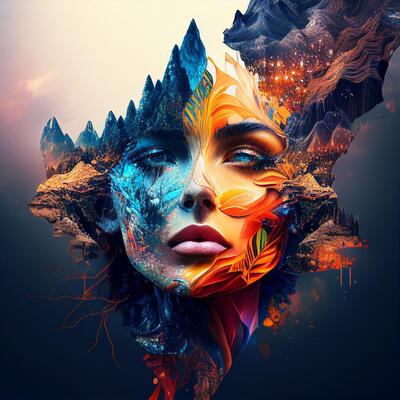Recognizing the Importance Behind Remarkable Trump Art Creations
Wiki Article
Exploring the Diverse Globe of Artistic Expression: From Surrealism to Abstract Realism
In the world of imaginative expression, from the dreamlike landscapes of surrealism to the elaborate play of light and type in abstract realistic look, musicians have actually continuously pressed the borders of creative thinking and imagination. As we discover the multifaceted world of art, we are presented with a tapestry of styles, techniques, and approaches that test our understanding and prompt contemplation.Surrealism: Unleashing the Subconscious
Surrealism, an avant-garde creative activity of the 20th century, dug right into the midsts of the subconscious, unveiling a world of dream-like imagery and non-traditional juxtapositions. Headed by musicians like Salvador Dali, René Magritte, and Joan Miró, Surrealism looked for to test the conventional ways of seeing and understanding art. Through techniques such as automatism and dream analysis, Surrealist artists aimed to use the unconscious mind to reveal hidden truths and desires.One of the crucial elements of Surrealism was the focus on the illogical and the incredible. By incorporating unanticipated components in their jobs, Surrealist artists aimed to create a feeling of disorientation and shock in the audience. This interruption of logic and reason was suggested to prompt a deeper exploration of the subconscious and the enigmas of the human subconscious.
Abstract Realistic Look: Redefining Understanding
Testing typical creative limits, Abstract Realism redefines assumption with the fusion of recognizable components with abstract types. This innovative approach to art incorporates the representational precision of realistic look with the imaginative flexibility of abstraction, offering visitors a special visual experience that prompts them to question their assumption of reality.In Abstract Realism, musicians strive to record the essence of their topics while likewise infusing their deal with a feeling of depth and intricacy with abstract elements. By mixing the acquainted with the strange, these artists welcome audiences to involve with their pieces on numerous levels, urging them to explore the subtleties of shade, texture, and kind.

Cubism: Fragmenting Truth
Making use of fragmented point of views and geometric kinds, Cubism changed the artistic representation of truth in the very early 20th century. Developed by Pablo Picasso and Georges Braque, Cubism sought to challenge traditional notions of point of view and representation. By damaging down things and figures into geometric forms and presenting them from several point of views all at once, Cubist artists aimed to catch the significance of the subject as opposed to its literal appearance. This technique not just deconstructed fact but likewise stressed the monotony of the canvas, paving the way for future abstract art motions.
Cubism can be categorized into two main phases: Analytical Cubism, characterized by monochromatic color design and intricate, fragmented forms; and Artificial Cubism, which included collection components and brighter colors into the compositions. Via these distinctive phases, Cubism influenced not only painting but also style, sculpture, and style. trump art. Its effect reverberated throughout the art globe, motivating artists to explore brand-new methods of interpreting and representing the globe around them
Expressionism: Feelings on Canvas
Exploring the midsts of human emotions through expressive and dazzling brushstrokes, Expressionism became a profound imaginative motion in the very early 20th century. Unlike previous art motions that concentrated on illustrating the external globe, Expressionism explored the interior world of the artist's subconscious, aiming to stimulate raw emotions and provoke visceral reactions from visitors.
Expressionist artists, such as Edvard Munch, Egon Schiele, and Emil Nolde, denied conventional ideas of charm and realistic look for misshaping form and color to convey subjective feelings. The usage of exaggerated brushwork, strong shades, and distorted numbers aided create read the article a feeling of worry, alienation, or interest in their works.
One of one of the most famous examples of Expressionism is Munch's "The Scream," which records the intense stress and anxiety and misery of modern life with its swirling, altered number against a blood-red sky. With their emotionally charged works, Expressionist musicians looked for to test conventional creative standards and provide a window right into the unstable depths of the human soul.
Contemporary Art: Advancing Point Of Views

One of the defining characteristics of contemporary art is its continuous advancement and ability to adapt to changing cultural landscapes. Artists are progressively including modern technology into their technique, blurring the lines between the digital and physical realms. This fusion of mediums permits ingenious methods of storytelling and engaging with audiences in a more interactive fashion.
Moreover, contemporary art typically functions as a system for social commentary, dealing with pressing issues such as identity, politics, and the environment. Artists are using their work to spark important discussions informative post and prompt thought, clarifying the intricacies of the globe we stay in. As viewpoints remain to develop, contemporary art remains a significant and dynamic force in forming our cultural landscape.
Conclusion
Finally, the globe of imaginative expression incorporates a wide array of designs and motions, each with its very own special technique to communicating meaning and feeling. From surrealism's exploration of the subconscious to abstract realism's redefining of assumption, and from cubism's fragmentation of truth to expressionism's representation of feelings, art continues to evolve and test point of views - trump art. Contemporary art reflects the ever-changing globe we reside in, offering brand-new methods to this hyperlink interpret and recognize the complexities of our realityAs we discover the diverse globe of art, we are provided with a tapestry of styles, methods, and viewpoints that test our understanding and provoke reflection. Its effect resounded throughout the art world, motivating artists to discover new means of translating and representing the world around them.

Report this wiki page